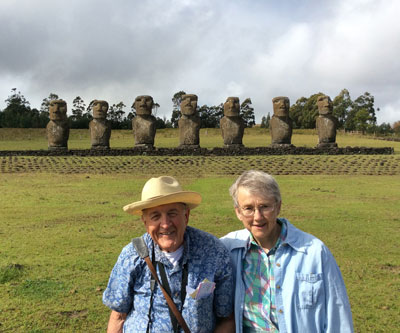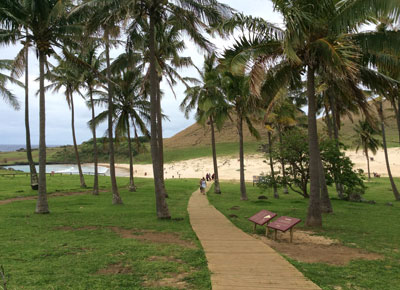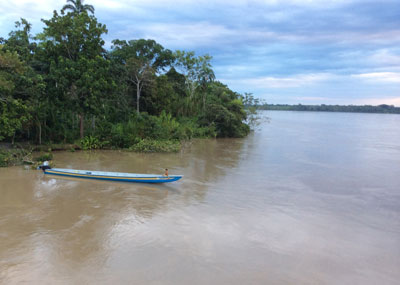French Polynesia, Easter Island and Ecuador – a trifecta of tours in 2015
This article appears on page 18 of the May 2016 issue.
After a rigorous winter in January and February 2015, with record snowfall and cold in Massachusetts, we decided that a visit to the tropics looked good, so we booked a week’s trip on the Paul Gauguin, sailing on March 28 from Tahiti to other islands in French Polynesia.
The cruise
Getting to the ship at Papeete, Tahiti, was not difficult via a transcontinental flight to Los Angeles and a transfer to Air Tahiti Nui for an 8½-hour flight across the Pacific. We arrived late in the evening and went immediately to the ship, which sailed for its first port, Moorea, only a few miles away.
Entering the port in early morning, we were greeted by a magnificent view. The rugged island and gentle tropical sky were a great welcome after winter’s rigors.
The Paul Gauguin, with about 330 passengers, travelers from all over the world, was very well managed. The food was excellent and the shore excursions really fun and informative.
We usually ate breakfast on the top deck, which had both indoor and outdoor service and offered an easy way to see the various islands as we approached for each day’s visit.
After Moorea, our itinerary included Huahine, Taha’a and the nearby private islet of Motu Mahana (all in the Society Islands) as well as Bora Bora, with a return to Moorea and disembarkation in Tahiti.
Each island visit offered several tours. We generally took an excursion into the interior and met some interesting locals, including the day’s guides. Transport was by tender from the “mother ship.”
The scenery was magnificent and the islands were undeveloped, with most of the resorts being low-key. The weather was perfect; it was the end of the rainy season, and we had only one brief shower during our whole stay!
A few highlights
Just off Taha’a, we visited the beach on Motu Mahana, a small island that belongs to Paul Gauguin Cruises. After landing there, we had the chance to swim, have a barbecue and generally enjoy our “private” tropical island.
One of the highlights of the trip was a full-day excursion on an outrigger around Bora Bora. There were eight of us along with the vessel’s very colorful captain, who was clad only in sharks’ teeth and a G-string. He entertained us with songs and stories, and, along the way, we were able to enjoy the warm water, swim with sharks and get up close to stingrays, which seemed very curious about us.
The excursion concluded with a Polynesian feast on another private island that included roast pig, various chicken and fish dishes, manioc, plantains, breadfruit and coconut milk plus bananas sautéed with vanilla for dessert. It was a real feast, which we ate sitting at tables in the water, shaded by umbrellas. It was quite a day!
On our next-to-last day, we visited a number of archaeological sites on Moorea, including some that were once used in sacred ceremonies. It was interesting to walk down from the highlands through pineapple plantations, pine groves and other exotic vegetation.
We landed in Papeete all too soon. There we had a chance to walk around the city.
Tahiti is the only really developed island in French Polynesia. It is an “overseas country” of France and redolent of the colonial days. The downtown area of Papeete included some lovely old buildings, including the Hôtel de Ville (Town Hall) and a large indoor market — a colorful place to visit.
We did have one tour on the island of Tahiti in the vicinity of Papeete, which included, at nearby Arue, an interesting visit to the large and airy former home of James Norman Hall, who wrote “Mutiny on the Bounty” with Charles Nordhoff.
We returned home to Massachusetts in early April hoping winter was finally over. We’d had a very worthwhile (and highly recommended) visit to a part of the Pacific that has a lot of history. Our cruise, booked through Avoya Travel in Ft. Lauderdale, Florida (888/447-8459, avoyatravel.com), cost a total of $10,308, including international airfare.
Easter Island
Easter Island, in the most eastern part of Polynesia, was another destination we had long wanted to visit.
We had planned a trip in 2010, but an earthquake shut down the Santiago, Chile, airport, cutting off our access to the island, so we had to postpone the journey.
In 2015, we were able to combine a short trip to Easter Island with a brief visit to the Amazon Basin, which we booked through Pacific Holidays (New York, NY; 800/355-8025, www.pacificholidays.com) for a total of $11,878, including all air travel, accommodations, some meals, all guides and drivers and a river cruise aboard the Manatee Amazon Explorer.
So, in early August, we departed once again for the Southern Hemisphere, this time by way of Miami to Santiago, Chile, continuing on a 6-hour LAN Airlines flight to Easter Island, located halfway between Santiago and Tahiti.
Our flight landed in Hanga Roa, the only town on Easter Island, at the Mataveri International Airport, a partly open-air facility reminiscent of places in Hawaii we had visited years before. It was a sort of homecoming for the locals on our flight, with loads of people meeting the plane. The island’s population of about 6,000 depends on the daily flight and the weekly freighter, which brings heavy goods.
At the small terminal, we collected our bags amid a crush of people and met Hugo, a Rapa Nui native, who drove us to the Taha Tai Hotel. We had a bungalow with a deck just a few steps from the restaurant, with ocean views. Exotic South Sea vegetation and birdsong were integral parts of the grounds, and it was very quiet.
The weather wasn’t tropically warm but was comfortable, mostly in the 60s and low 70s, and it was definitely changeable, going from sun to mist to drizzle to windy, clear skies in a matter of hours.
Food on the island was excellent, with especially good seafood. With so many restaurants, there was no dearth of places to eat.
Hanga Roa is a very low-key town, consisting of several streets with little shops and restaurants. There was a palpable sense of community. Everybody seemed to know each other, and those we met were very friendly.
Our guide was Emelia and our driver, John. Emelia also teaches traditional dancing, and John danced in a spectacular cultural show, which we would see later in our trip, featuring the best male dancers we have seen in such a performance.
Seeing the sights
We started our tour with Emelia at Rano Kau, a volcanic crater on the southwestern tip of the island. Located there is the stone village of Orango, central to the Birdman cult that once inhabited the island.
Historically, toward the end of the era of the settlement of the island by Polynesians, before foreign intervention, the Birdman cult came about to create a sharing of power and resources. The cult, itself, was focused on the annual arrival of sooty terns on Motu Nui, situated just off the shore.
Tribes would each send a strong tribesman to swim over to the motu to retrieve an egg laid by one of the returning birds, and the first to bring one back undamaged to the head of his tribe would empower his people to rule over the island for the ensuing year.
Orango was used for ceremonial purposes only, and it was there that those who participated in this ritual would stay during the time of the ceremony.
After viewing Hanga Roa and the 2-mile-long airport runway from the hill at Orango, we went next to the location where the island’s famous carved stone heads were produced. These statues, or moai, were carved at a quarry at the Rano Raraku volcano and then transported to various sites on the island, mainly at the shore. There are still many partially finished statues in the area.
The ahu are the stone platforms upon which the statues were placed. They are sacred, and one must not approach a moai any closer than the stone outlines of the ahu.
The largest grouping of statues was at Ahu Tongariki, featuring 15 moai in a row dating from various periods. This UNESCO World Heritage Site was most impressive. Located near the beach with steep cliffs and an offshore motu, the setting was very dramatic.
Late one afternoon we were privileged to meet young Scotsman James Grant-Peterkin, who came to the island a dozen years ago, loved it and stayed. He established the tour company Easter Island Spirit and wrote a guidebook “A Companion to Easter Island,” which we found extremely helpful and well written. It focuses on the island and all its characteristics — history, archaeology, geography and so forth. It is available in a number of languages and can be found on the island in souvenir stores or online from Amazon.com.
Mr. Grant-Peterkin was a most interesting man. He is also the British honorary consul, and everybody seemed to know and like him.
Heading to the Amazon
All too soon we had to fly back to Santiago, surrounded by the snowcapped Andes (it was winter there). We spent a night at the Renaissance Hotel before taking the next morning’s Avianca flight to Bogotá, Colombia, continuing on to Quito, Ecuador, for another overnight.
In the morning we took a TAME flight to Coca, an oil boomtown on the Napo River. We had visited Coca previously and could see that the town had expanded noticeably over the last decade, though it was still a rather scruffy place. We passed several oil camps along the Napo, and barges traveled up and down the river endlessly. It does not bode well for the future of the rainforest there.
We were going to visit several national parks. Hopefully, these enclaves will protect some of the Amazon’s habitat.
The Manatee Amazon Explorer was a typical riverboat, which we boarded after motoring downstream from Coca on a longboat canoe for several hours. Due to rain and snowmelt, there was a powerful current in the river, which was twice as wide as the Mississippi in its lower reaches and full of logs and other debris.
Our guide for the trip was Raoul Romero, a Quechua. He was an amazing person and quickly placed in our pantheon of really great guides — articulate and well versed in the flora, fauna, geography and customs of the area. Raoul ate all meals with us and took us for all of our excursions, during which we saw a variety of birds, monkeys and interesting insects.
The Manatee can accommodate 24 passengers, so with only five of us on board, we were treated most royally. In addition to us, our group included two ladies from Australia and Henry Rollins, who turned out to be a fascinating man.
Henry, who was born Henry Garfield, grew up in Washington, DC. As frontman for Black Flag and The Rollins Band, he once had kind of a “bad boy rocker” image, but he now travels the world working on articles for LA Weekly and on shows for National Geographic and H2 (a spinoff of the History Channel). He had been to more remote places and told more interesting stories than anyone I’ve ever met.
We explored Yasuni National Park on several excursions, both on foot and by longboat canoe in backwater areas that were quiet and peaceful, with abundant birdsong and no evidence of the oil prospecting going on close by.
Too soon we had to return to Quito, where we had a guided tour later in the afternoon and into the early evening, ending with a spectacular view of Quito from the top of the hill where there is a statue of the Virgin Mary with wings, a rare depiction. As the city lights were coming on, it was a beautiful sight.
Quito has a huge new airport — very modern, with an expressway connecting it to the city 22 miles away. This has eased travel to and from Quito considerably. A local volcano, Cotopaxi, had been erupting and delaying flights, but on the day we left, Aug. 18, it did not cause a problem. The snow-covered cone was a magnificent sight from the airport as we took off and headed back to Miami.
Going through Customs and Immigration in Miami was awful. If you can avoid Miami when entering the country, do so. It was an absolutely chaotic and needlessly disorganized process. It took 1½ hours, and we barely made our connection to Boston, with only minutes to spare.
Other than that, it was a wonderful trip, and we can highly recommend both of these unique locations.




